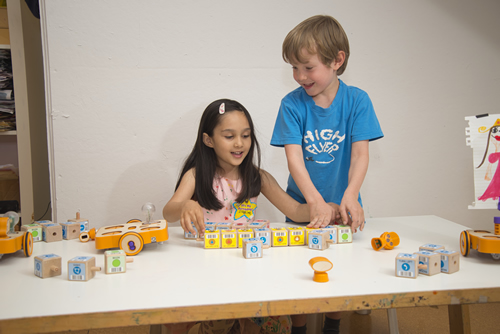Before March 2020, there were many conversations about the benefits of minimizing screen time for young learners. Since the pandemic hit, educators and parents have had no choice but to rely on screens to reach and teach students. But screen-based learning is not always developmentally appropriate for young learners, and it is not well suited to some forms of learning. STEAM lessons in particular, with their exploratory and experiential elements, may seem impossible to deliver in a remote learning model.
But with the right tools and the right approach, we can keep engaging our young learners in STEAM. Here’s how educators, whether they’re teaching 100% virtual or in a blended learning environment, can teach STEAM concepts in a hands-on, playful way.
Grounding learning in hands-on manipulatives
Jean Piaget, an influential educational theorist who explored the way young children learn concepts, described their cognitive development as progressing by stages toward more abstract thinking. Children in preschool and early elementary grades are in what Piaget called the “pre-operational” stage. They are grounded in the physical world, and they engage with concepts through the objects and materials immediately at hand. To think about abstract concepts that aren’t immediately tangible to them is a cognitive skill that children do not develop until later.
Related content: Learn how STEAM supports creativity and confidence
As a result, young learners aged 2 to 7 learn best by experimenting and engaging with concrete objects. When introducing new ideas, educators can ground lessons with physical objects that students can touch, feel, and move around in a physical space. That’s one of the reasons robotics is an effective way to introduce computer science, engineering, computational thinking, and critical thinking—the robot becomes a physical expression of the STEAM concepts that the teacher presents. If young students learn the foundations of coding using a physical object like a robot, they will be more successful in constructing their own understanding of the abstract concepts of sequencing and algorithms.
Physical manipulatives also support developmentally-appropriate play, and for young children, play is a foundation of learning. Toys like the KIBO robot or LEGO bricks are hands-on resources for imaginative play that help young students build critical problem-solving skills by engaging their imagination. For many children, the entry point to motivation is fantasy play or role play: programming a robot is about inventing a character, and building a structure is creating a setting for a story. Hands-on learning tools like blocks, boxes, and arts and craft materials also allow the child to explore new concepts through concrete play.
Inspiring experimental learning
Speaking of imaginative play, positioning a young student as an explorer or inventor can kick students’ imaginations into gear. Educators or caregivers can give students a learning experience that doesn’t direct them to one possible solution, but encourages them to tackle a problem with open-ended materials. Playful learning is about encouraging children to take on an attitude of inquiry and investigation and to invent their own solutions to problems educators pose for them, without directing them to one “right answer.”
Open-ended, exploratory experiences should be at the heart of STEAM education for young children. Some of the most effective things educators or caregivers can do is give students time and space with a set of materials that don’t have one obvious way to work.
The engineering design process, a staple of STEAM education, provides a framework to clearly define and solve problems from beginning to end. The process acknowledges the importance of experimentation and testing alongside planning; for young children, “planning with your hands” is common as they learn to use new materials and techniques in an open-ended way.
Open-ended STEAM experiences are actually a great fit for distance-learning activities in students’ homes, where blocks of open time are perhaps more available than in the classroom. For example, educators and caregivers can give children a range of common recycled craft materials like pieces of cardboard, sticks, string, and pipe cleaners, and then ask them to create a bridge between two tables that’s strong enough to carry a toy truck. Just allowing them to experiment with the materials to reach a goal can give them room to work around problems until they succeed on their own time. How does the bridge fail, and how can they make it stronger? Without a specific recipe to follow, children can explore the materials and learn from the process itself.
Supporting collaboration at a distance
In KinderLab’s curriculum, the final step in the engineering design process is sharing. One of the most powerful ways of making learning meaningful for children is to give them the opportunity to explain and present their creations to others. They can share their interests and discoveries with their peers and become conscious of the “why” behind their decisions when they see how the projects they’ve created have an impact on their peers.
Even in a distance learning environment, students can work on something on their own at home and then share the finished product with a small peer group. This can be done through online meetings where children’s work can be showcased, and peers and teachers can share their feedback. No matter what the fall looks like, I hope that we hold onto the notion that what young students do is important to their peers and has a communicative power. It’s something we really don’t want to lose during this time of distance learning, when students can feel isolated.
There’s no doubt that students will spend some time learning on screens this fall, but hands-on experiences that take them off the screen and allow them to engage in learning with physical manipulatives are as important as ever.
- Motivating students using the Self-Determination Theory - April 17, 2024
- Michigan Virtual’s statewide workgroup releasing AI guidance for K-12 educators - April 17, 2024
- 5 obstacles AI can help schools overcome - April 16, 2024

